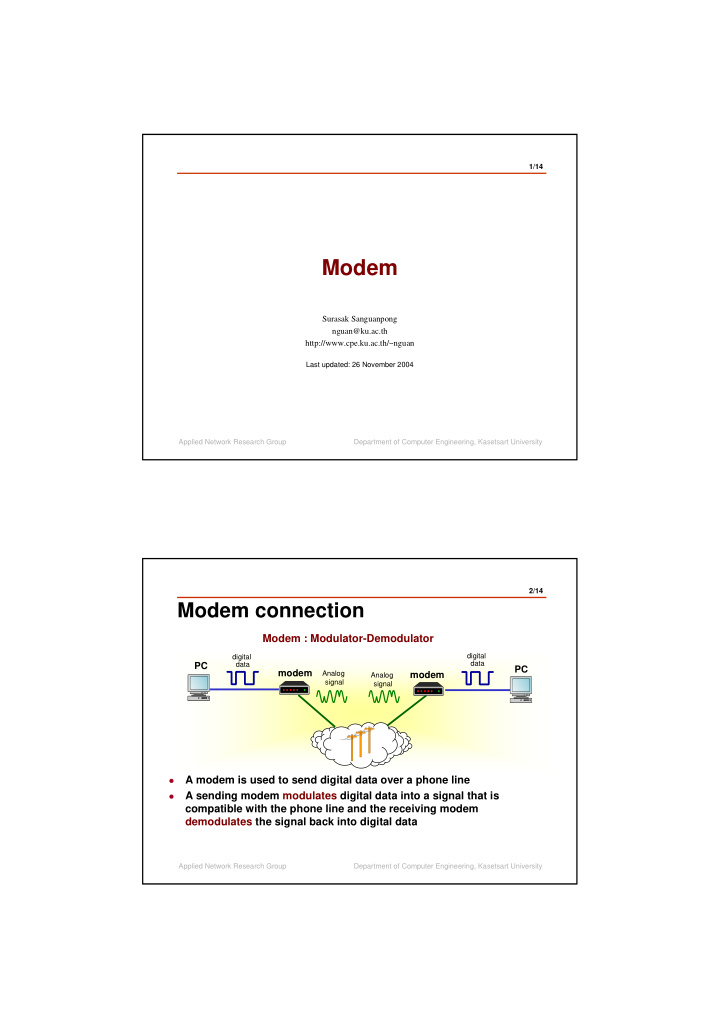



1/14 Modem Surasak Sanguanpong nguan@ku.ac.th http://www.cpe.ku.ac.th/~nguan Last updated: 26 November 2004 Applied Network Research Group Department of Computer Engineering, Kasetsart University 2/14 Modem connection Modem : Modulator-Demodulator digital digital data data PC PC modem Analog modem Analog signal signal A modem is used to send digital data over a phone line � A sending modem modulates digital data into a signal that is � compatible with the phone line and the receiving modem demodulates the signal back into digital data Applied Network Research Group Department of Computer Engineering, Kasetsart University
3/14 The Original of Modem Dumb Mainframe Terminal modem modem Modems came into existence in the 1960s as a way to allow terminals � to connect to computers over the phone lines A dumb terminal at an off-site office "dial up" to the mainframe using � 300 bps modem Applied Network Research Group Department of Computer Engineering, Kasetsart University 4/14 300 bps Full Duplex Modem Originate modem Answer modem (sender) (receiver) PSTN bandwidth Hz 1070 1270 2025 2225 0 1 0 1 Modulator Demodulator Use Frequency Shift Keying (FSK) � Space=1070 Space=1070 Mark=1270 Mark=1270 D The originate and answer modems use D � T T E E different tones, they can both use the Demodulator Modulator Space=2025 Space=2025 line simultaneously (Full-duplex Mark=2225 Mark=2225 operation) Applied Network Research Group Department of Computer Engineering, Kasetsart University
5/14 Modulation Techniques ASK Not used for modem ASK FSK FSK Low speed modem Modulation PSK higher speed modem PSK ASK+PSK ASK+PSK Very high speed modem TCM TCM Applied Network Research Group Department of Computer Engineering, Kasetsart University 6/14 Modem Operating Mode Half Duplex V.S. Full Duplex Half Duplex Full Duplex Full duplex over four wires � � Half duplex over two wires � Full duplex over two wires with two channel of different frequency Dial up Dial up V.S. Leased line Leased line � Temporary connection between two sites � Private permanent connection between two sites � Each call to the same site might use � Constant line quality and the route is fixed different routes with different line quality � Offer higher speed with lower error rates wires Synchronous Synchronous V.S. Asynchronous Asynchronous � data are transmitted one character at a time � A block of bits is transmitted in a steady stream � synchronization is maintained within each � synchronization is maintain by a clock signal character with start and stop codes Applied Network Research Group Department of Computer Engineering, Kasetsart University
7/14 Bandwidth for Telephone line 300 600 3000 3400 Hz 2400 Hz for data 3100 Hz for voice Why 33.6 Kbps? � Applied Network Research Group Department of Computer Engineering, Kasetsart University 8/14 How modem achieves more speed? Answer : Signals encode multiple bits, the bit rate is a multiple of the baud rate. 4-PSK 8-QAM +90 ฐ =01 011 010 101 0 ฐ =00 +180 ฐ =10 100 000 001 110 +270 ฐ =11 111 1 amplitude, 4 phases : 2 amplitudes, 4 phases : 2 bits encoding in one signal change 3 bits encoding in one signal change bit rate = 2xbaud rate bit rate = 3xbaud rate Applied Network Research Group Department of Computer Engineering, Kasetsart University
9/14 Modem Standards Bell and ITU-T compatibility chart Bell ITU-T Bell ITU-T Baud rate Bit rate Modulation Duplex Mode 300 Full Sync/Async 300 FSK 103/113 V.21 Sync/Async 600 1200 4-PSK Full 212A V.22 1200 1200 FSK Half Sync/Async 202 V.23 1200 Full Sync 2400 4-PSK 201B/C V.26 1600 4800 8-PSK Full/Half Sync 208 V.27 2400 9600 Full/Half Sync 16-QAM 209A V.29 Applied Network Research Group Department of Computer Engineering, Kasetsart University 10/14 More ITU-T Modem Standards Baud rate Bit rate Modulation Duplex Mode V.22 bis Sync/Async 600 2400 16-QAM Full V.26bis 1200 2400 4-PSK Half Sync V.26ter 2400 Sync/Async 1200 4-PSK Full/Half V.27bis 1600 4800 8-PSK Full Sync V.27ter 1600 4800 Half Sync 8-PSK V.32 9600 Sync 2400 TCM Full V.32bis 2400 14400 TCM Full Sync V.33 2400 14400 Full Sync TCM V.34 28800 Sync/Async 2400 TCM Full Applied Network Research Group Department of Computer Engineering, Kasetsart University
11/14 Interface V.S. Operating rate interface speed operating rate PC modem 115.2 Kbps 33.6 Kbps With 4:1 compression a V.34 Modem can � receive data at 115.2 Kbps from PC The 33.6 Kbps limit of the telephone line is not � exceeded Applied Network Research Group Department of Computer Engineering, Kasetsart University 12/14 Fallback 12,200 bps modem modem Down speed 9,600 bps modem modem 4,800 bps modem modem Applied Network Research Group Department of Computer Engineering, Kasetsart University
13/14 56 Kbps Modems Conventional V.34 Modem Central Central ISP Home Office Office V.34 Analog V.34 Digital Analog Digital CO CO CO CO 33.6 Kbps Analog Digital Analog 33.6 Kbps Analog Analog Digital V.90 Modem Home ISP V.90 V.90 Analog Digital Digital Digital CO CO CO CO 33.6 Kbps Analog Digital 56 Kbps Analog Digital Applied Network Research Group Department of Computer Engineering, Kasetsart University 14/14 Asymmetrical Stream From home, you transmit ISP V.90 acts Central Home as V.34 Office Digital Digital Analog A/D A/D Quantization noise 33.6 Kbps limits the data rate to To home, you receive ISP V.90 acts Home as V.90 Digital Digital Analog D/A D/A 56 Kbps No quantization noise (No PCM) Applied Network Research Group Department of Computer Engineering, Kasetsart University
Recommend
More recommend